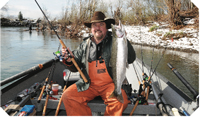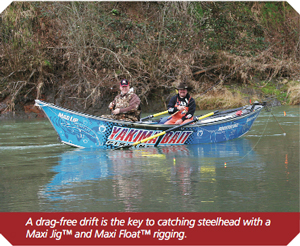Jig Fishing for Steelhead
RESEARCHED, TESTED, PROVEN, AND FREE ADVICE FROM THE EXPERTS
The steelhead yanked my bobber down with a vengeance. Seeing the bobber disappear so early in its drift made me scramble to flip the bail on my reel, take up the slack line, and set the hook before the fish threw my jig. Feeling the hook, the ten-pound fish immediately took off, sizzling line as it surged downstream 70 yards before clearing the water in a spectacular leap.
Wherever steelhead are found, anglers are experiencing success while using jigs. Fishing a jig under a float is one of the easiest fishing methods to master and can produce quick limits, even for a novice, since all you need do is watch your oat and set the hook when a fish pulls it underwater; however, this isn’t the only way to fish jigs for steelhead, since some anglers are finding success using them without a float.
WHERE TO FISH JIGS
Ideal, “textbook” steelhead water is 4-to-8 feet deep running at walking speed. Of course, this isn’t the only place you’ll find steelhead. Rifles, tail-outs, pools, and rapids all hold steelhead at one time or another. In the winter, water clarity can range from muddy to crystal clear as rivers drop into shape from rain and/or melting snow. Peak migration, from the ocean or giant lake to river, often occurs during or just after high water events. When rivers first drop into shape, turning from brown to green/clear in color, is considered “prime time” for steelhead. Jigs are most effective in clear water.
Winter steelhead have a penchant for holding in the tail-outs. That is, the lower third or downstream end of a hole or drift, which is the first resting water located above fast-water rapids. They will often be hugging the deep water side of a tail-out where a steep bank extends into the river. Other places worth trying are just downstream of large boulders or root wads, immediately downstream from underwater drop offs, and along current edges. When rivers are low and clear, fish can move into areas that afford some kind of protection; for example, they may be found in the center or top end of holes, in well-defined deepwater slots, and in fast water sections where the current is broken up by bottom ledges or strewn with large rock. And although steelhead will respond to jigs anywhere they’re found, slow-moving water and current edges is where this fishing method outshines all others.
Where steelhead consistently hold in deep water (10-to-20 feet) is in areas like the Columbia and Snake Rivers, where summer steelhead winter over before moving into spawning tributaries as waters warm in the spring.
JIG N’ FLOAT KNOW-HOW

If you’re fishing a current edge, that is, where slack and moving water meet, on the near side of the river, you should have no problem with line drag. It may be a different story if you’re casting out into a hole or drift where the current, especially a strong one, can grab your main line the moment it hits the water surface and pushes it downstream faster than your oat is moving.
One way to reduce or momentarily eliminate line belly and its effect on maintaining a natural drift is to mend your line. Line mending is something y anglers do, for the same reason, to prevent their y from skating downstream too fast. To mend your line, start with your rod at a low angle and pointed at your oat, progressively pull your rod up and backward (toward you) while rolling your rod tip and line upstream. When you mend, it’s important to do so aggressively enough that your main line will be tossed upstream all the way to your oat. Given a strong current, you may have to mend your line several times during a single drift.
Casting out at a slight downstream angle and feeding line off your reel fast enough that your bobber won’t be overcome by line drag can reduce or eliminate the effects of line belly on your bobber. If you’re a boater, you can cast out to the side or at a 45-degree angle downstream too, but you may find better success and eliminate all line drag by anchoring above the area you wish to fish and maneuver your bobber n’ jig directly downstream.
Surprising to some, steelhead will come off the bottom to take a jig; for example, if the water is clear, your jig should only have to extend halfway to the bottom. If the water is deep, eight feet or more, you might find better success positioning your jig within a few feet of the bottom. You should realize, in all cases you do not want your jig to bounce the river bottom, which is good news for anglers weary of snagging bottom and then having to spend valuable fishing time re-rigging.
RIGGING AND TACKLE
Rigging is easy, since all you need is a bobber threaded on your main line with a jig suspended below it. Because you’ll be fishing different water depths, requiring you to vary the distance from your bobber to jig, you will want to choose a bobber style, like the Maxi Float™, that can be quickly and easily moved up and down your line via a friction fit.
Although mono lament lines work, they don’t oat very well as compared to super-line, which is the main reason a growing number of anglers are employing super-lines for this fishing method. Other reasons anglers are switching is because super-lines offer thin diameter, last for years, have almost no stretch (this helps ensure strong hook sets), oat well (especially when treated with y line dressing), and handle like a dream on a spinning reel because, unlike mono lament, they absorb line twist. What I use is Berkley® Fireline® because it has all the above features and is available in a fluorescent green color I can see.
Whatever super-line you try, splice a two-to-three foot length of clear or low-vis green mono lament leader (or invisible fluorocarbon) to its end and attach your bobber to your main line. A Uni-to-Uni knot works best when splicing mono or fluorocarbon to super line. When fishing shallow water tail-outs that are three to four feet deep, I’ll often have my jig suspended 18-to-24 inches below my oat, which is why I keep my leaders fairly short and attach my oat to main line.
Since your jig may only weigh one-eighth ounce, along with a bobber just large enough to oat it, casting can be difficult unless you use light line (6- to 12-pound test mono or 14- to-20 pound super line) combined with a spinning rod and reel. In addition, river currents have less in influence on thin diameter line, which makes light test lines especially appealing to anglers specializing in this fishing method.
Trying to cast a bobber with a jig trailing six feet or more from your rod tip can make you wish for a longer fishing rod. Most fishing rods used specifically for the bobber ‘n jig method are nine-to-ten feet in length or more and of a light (L), medium light (ML), or medium (M) action. A benchmark to consider when choosing a quality reel capable of landing a hard fighting fish like a steelhead is one having drag washers cut from sheet graphite (like the Carbon Matrix™ drag system offered by Abu Garcia®) that will hold its adjustment and maintain absolute smoothness.
Long-shaped oats that will tip with the slightest drag will tell you what’s going on better than round ones. My favorite is the Maxi Float™, which is available in 1/16, 1/8, and 1/4 ounce sizes –meaning that’s the amount of weight each size will oat. In addition, Maxi Float™ wire-eyelet design eliminates oat loss due to tubing failure, its friction t is secure due to it being held in place by two sections of 3/16 inch surgical tubing, and Maxi Float™ offers an increased amount of casting weight.
Yakima Bait’s Maxi Jig™ was designed with the serious steelheader in mind. The Maxi Jig™ is a premium jig featuring pulsating marabou dressing, 2X Owner® hook and to reduce paint chipping, has a durable UV impregnated two-part urethane overcoat applied to the heads. The most popular Maxi Jig™ sizes for winter steelhead are 1/8 and 1/4 ounce. For low water, small stream, or summer conditions a 1/16 or 1/32 ounce size might produce best.
When fishing winter steelhead in emerald green water color try using a 1/4 oz. Maxi Jig™ tipped with the last few inches of a pink worm (I do this using the PowerBait® scent-filled steelhead worm), which can add to your success. Tipping your jig with a chunk of prawn, sand shrimp or coon shrimp tail also works.
Steelhead respond best to jigs presented in a horizontal fashion. This can be achieved by making sure your line tie is positioned at the top of your hook eyelet. Jigs come in different colors, which can make all the difference in your success. Although Pearlescent Pink (PLSP) is the best-selling jig finish in many markets, it is not the only one that works. While there are basic rules to follow in regard to jig color (see below), don’t discount on-the-water experience. What I do is try different jig colors based on conditions and let the fish tell me what they like, which they will quickly do.
TWITCHING JIGS
Surprising to some, you can cast jigs and hop/twitch them back to you while they arc/drift downstream in the current. Because jig design causes the hook point to ride/point upward, jigs get hung on bottom far less than one might think. While strikes can be subtle, many are easily recognizable. It’s important to set the hook hard if/when feeling a take.
JIG FISHING TIPS
- Never smear oil-based scent products directly on a marabou or feathered jig as doing so will mat the feathers spoiling their pulsating action.
- Drop down in jig size for small streams or clear water when metallic or dark color combination might produce best. Productive colors include Black Pearl (BP), Blue (BLU), Black Magic (BMAG), Metallic Lavender (MLAV), Metallic Red (MRED), or Pearl Nightmare (PLNM).
- In “steelhead green” water 1/8 and 1/4 ounce sizes are good choices. Popular colors include Pearlescent Pink (PLSP), Egg Fluorescent (EFL), Calypso (CAL), Cerise (CER), Glitter Pearl Red (GPLR), and Pearl Nightmare (PLNM).
- In more turbid water or low light try large jig sizes in colors like Luminous (LUM), Peach Luminous (PLUM), Sunrise (SUN), and Red Hot Tiger (RHT).
 About the author: Although not a guide, Buzz is considered a sport fishing
About the author: Although not a guide, Buzz is considered a sport fishingauthority for salmon, steelhead, and trout. He writes a regular outdoor column, is a seminar speaker, and has appeared on many TV fishing shows. He is a hall-of-famer for The Association of Northwest Steelheaders and The National Fresh Water Fishing Hall of Fame. Berkley offers a line of Air IM-8 rods Buzz Ramsey designed for salmon and steelhead. Currently, Buzz is Brand Manager for Yakima Bait Company and a member of the management team



